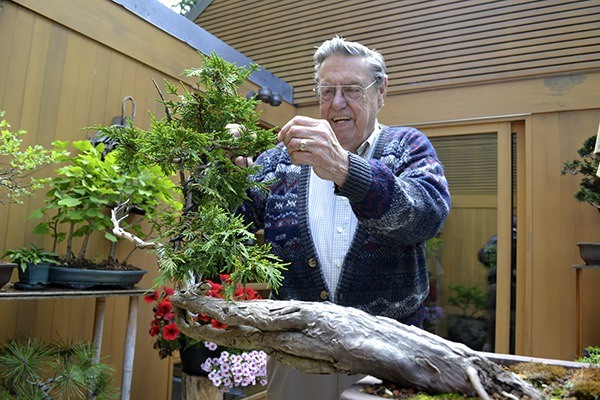Dungeness Bonsai Society’s annual show
When: 10 a.m.-4 p.m., Friday-Saturday, June 19-20
Where: Pioneer Memorial Park, 387 E. Washington St.
Cost: Free
More info: https://dungenessbonsai.wordpress.com
Whether you saw one in a friend’s garden or saw a picture in a magazine, bonsai trees are an art form and hobby that members of the Dungeness Bonsai Society feel is for anybody.
The taste buds for bonsai, pronounced bone-sigh, range from buying a few seeds for a starter tree to decorating your home with hundreds of trees.
Members from Poulsbo to Sequim to Port Angeles show off 50-plus plants to pique your interest from 10 a.m.-4 p.m. Friday-Saturday, June 19-20, at Pioneer Memorial Park, 387 E. Washington St.
Richard Bartha of Port Townsend is one of the rare club members to still have his first tree, a juniper squamata, he bought in 1972 on Long Island, N.Y.
“I did some bad things to it but I managed not to kill it,” he said.
The former Rutgers University microbiology professor said he first read about bonsai trees in a magazine and it sounded like magic to him.
Years later he visited the United States National Arboretum in Washington, D.C., and soon thereafter bought his first tree.
Fellow bonsai enthusiast Charlie Anderson of Poulsbo said a friend from Bainbridge Island got him into it.
“He told me he can’t stand it anymore. He had to do it as a kid (in Japan) with his father,” Anderson said.
“I started by putting in a Japanese garden at the house and having a couple of plants in the garden. Then we moved to a new house and decided to have a bonsai outside these two windows. Those two grew to 20 and grew to 80.”
An art form
Club president Bob Stack said many club members’ passion for bonsai comes from a love for horticulture but they also love the art aspect.
“Bonsai is a living sculpture that’s never quite finished,” Bartha said.
Anderson said he believes bonsai is the only 4-D art form because it includes height, width, depth and time.
“Regardless of the age of the material, you are trying to make it look very, very old,” he said.
His wife Ruth Anderson said, “You follow the same rules of any art for balance, depth and the rule of three.”
While bonsai owners with the Dungeness Bonsai Society may be experts now, they all agreed you need hands-on experience with the trees and time to learn.
“It’s a definite learning curve and can be quite complicated,” Stack said.
“It’s complicated because of shaping the tree, growing it, keeping it alive, coming to grips with watering, soil and repotting. Watering can kill bonsai more than anything.”
Anderson said the biggest fallacy is that bonsai are meant to grow indoors.
“People think that because they see bonsai indoors in pictures,” he said. “They can come in briefly for entertaining or pictures but then they need to go back out.”
Bartha, who teaches an introductory course for the club, said everyone makes mistakes with their trees and it’s a good idea to start small with an inexpensive plant.
However, Bartha said he’s never paid more than $15 on a tree while others say prices can go upwards of $2,000.
The Dungeness Bonsai Society also offers an auction at its September meeting for trees to offer an opportunity to obtain established trees for a good price.
The society was established in 1976 and has held an annual show ever since. It’s boasted upwards of 100 members and meets once a month at 10 a.m. the first Tuesday of each month. Its next meeting is July 7 at Pioneer Memorial Park.
For more information, visit https://dungenessbonsai.wordpress.com.



